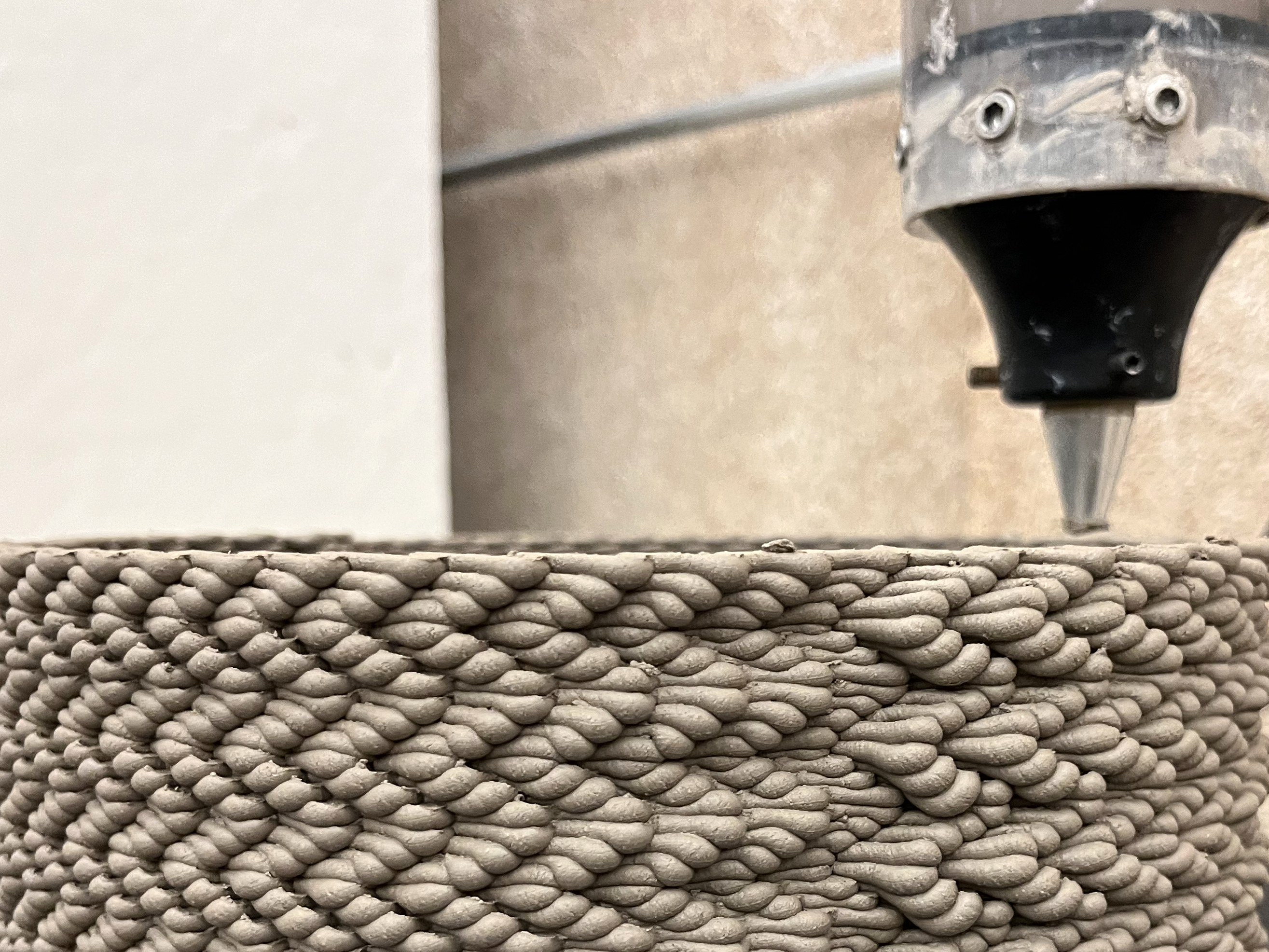Exhibit Columbus “Public By Design”
University Research Design Fellowship 2022-2023
Pipe UP! Installation
BLDS Team
Tamek Baba
Forbes Lipschitz
Shelby Doyle
Halina Steiner
University Research Design Fellowship 2022-2023
Pipe UP! Installation
BLDS Team
Tamek Baba
Forbes Lipschitz
Shelby Doyle
Halina Steiner
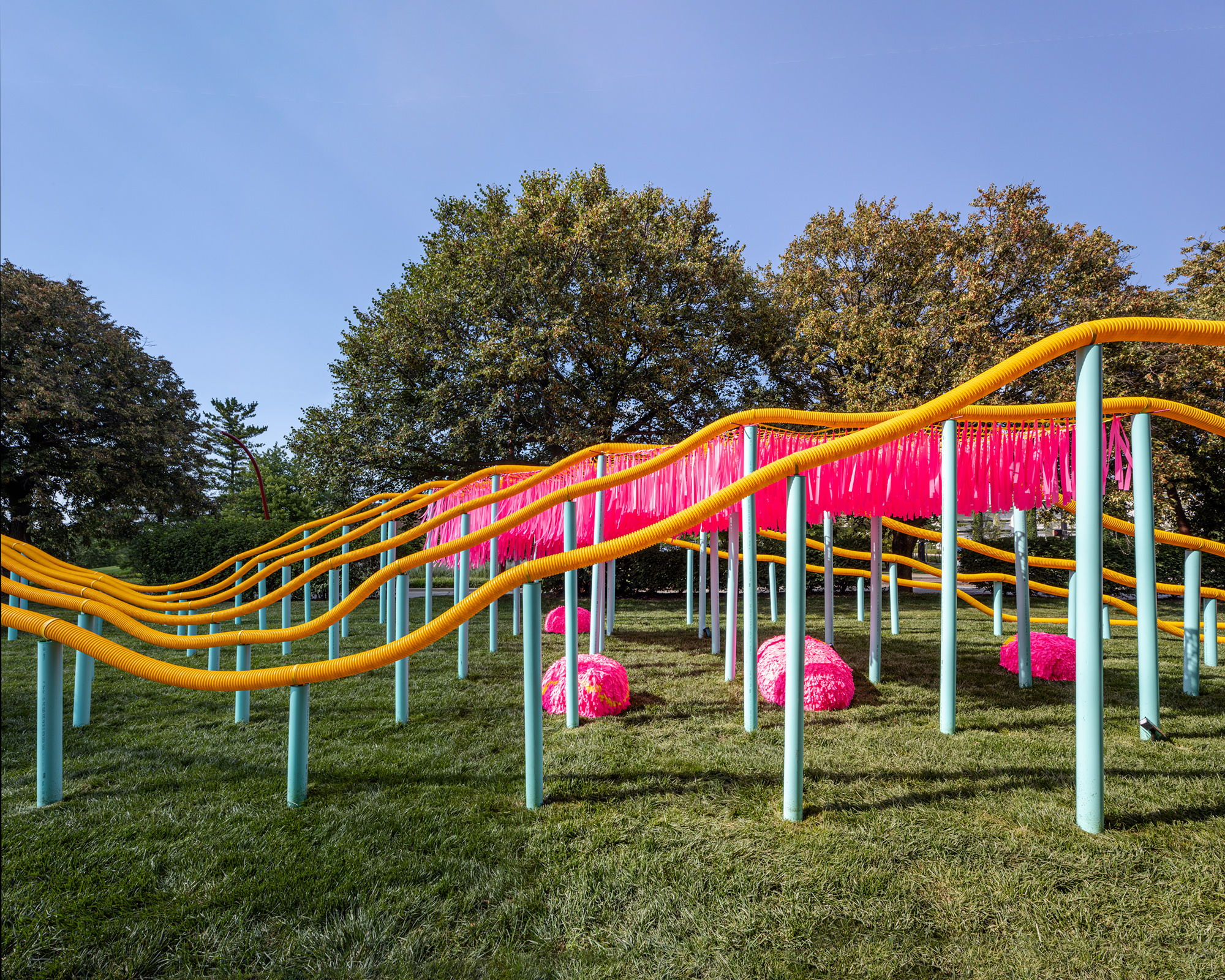
A vast network of buried pipes moves water throughout the built environment. They can also transport excess nutrients, dissolved pollutants, and sediment-bound toxins to downstream water bodies, contaminating freshwater sources and impairing the health and vitality of aquatic ecosystems. As an installation, PIPE UP! makes visible the subterranean water infrastructure of urban development and agricultural production, telling a visual, kinesthetic story about altered hydrologies. Composed of four site elements using off-the-shelf products, PIPE UP! is a standing field of 150 charlotte pipes topped by 700 feet of undulating tile drains. Three suspended rain clouds made of flagging tape and 12 poufs representing toxic sediment scattered across the site help to create a vibrant and tactile display of invisible infrastructure. PIPE UP! seeks to facilitate events and conversations about the future role of water in local riparian corridors and across the Mississippi River Watershed Basin
Photo credits: BLDS, Hadley Fruits for Landmark Columbus, and Robert Granoff.
Acknowledgments: Generous tile drain donation by Baughman Tile Co, Fabrication and design support by OSU Landscape Architecture students Blake Chapman and Maggie Chafin, 25 students from the Center for Architecture and Design High School Design Studio, 20 Pouf party volunteers from the Columbus, Ohio community Hotel Indigo Columbus Architectural Center, Knowlton School MAT/FAB Lab College of Engineering at The Ohio State University 2023 College of Engineering Undergraduate Summer Research Program, Iowa State University College of Design. Financial and administrative support from Knowlton School.




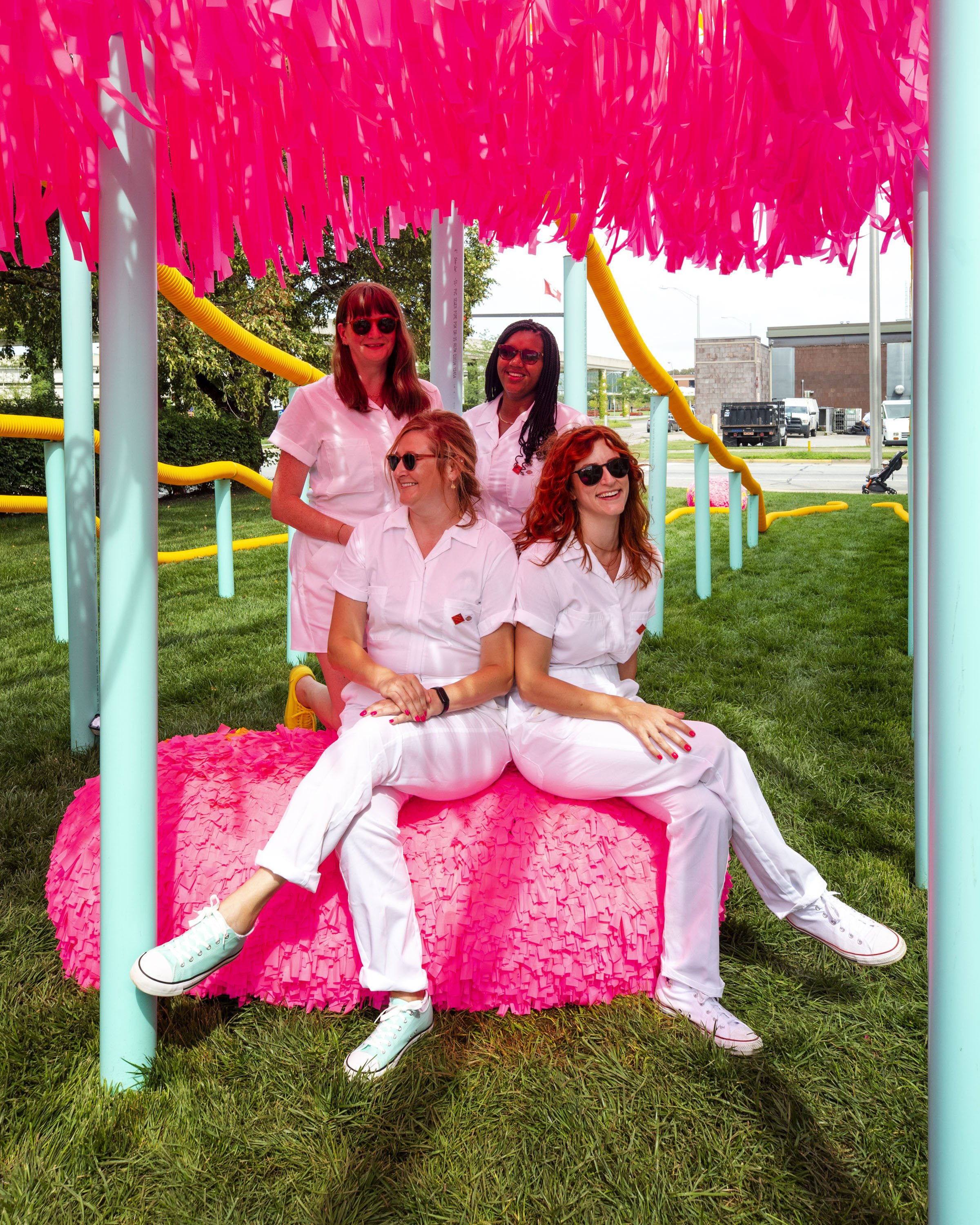

Exhibit Columbus “Public By Design”
University Research Design Fellowship 2022-2023
Pipe UP! Exhibition
BLDS Team
Tamek Baba
Forbes Lipschitz
Shelby Doyle
Halina Steiner
University Research Design Fellowship 2022-2023
Pipe UP! Exhibition
BLDS Team
Tamek Baba
Forbes Lipschitz
Shelby Doyle
Halina Steiner

Adjacent to the installation in the lobby of Hotel Indigito an exhibition “Where Does Your Water Go?” connectedthe built work to the water infrastructure of the Mississippi River Basin and resonated wtih the curatorial them of Public by Design for the fourth cycle of Exhibit Columbus.
In cities, a complex network of pipes handles rainwater, waste water from toilets, and chemicals from factories. These pipes function like hidden rivers that sustain the functionality and well-being of our cities. Unfortunately, they often carry a mix of harmful things like metals, chemicals, and raw sewage into rivers and lakes.
In the countryside, farms often rely on pipes called tile drains. These pipes are used to keep fields from becoming too soggy, which helps crops grow better. However, these pipes can also transport nutrients and chemicals, such as fertilizers and pesticides, from the fields into nearby bodies of water.
Whether we’re talking about cities or rural areas, the pipes we use to handle water harm the environment. It is important that we find ways to improve the effects of these pipes on our lakes and rivers and the creatures that depend on them.We can do this by creating better methods to clean the water, changing how we farm, and making sure everyone knows how important it is to dispose of waste properly. By working together to find better solutions, we can make sure that our water is healthy for future generations.
Additionally, an instagram account allowed visitors to share their documentation and exeperience of Pipe Up.
Pipe Up Instragram

Public By Desigh
The theme of the fourth cycle of Exhibit Columbus, Public by Design, built on the legacy of Columbus, Indiana to explore how collaborations between communities and designers could revitalize and reimagine historic downtowns as equitable, beautiful, and joyful places. Public by Design served as a platform for many vibrant communities to become connected around the values of inclusivity, care, and generosity. This cycle celebrated creative methods of collaboration that communities and designers could use to grow a sense of belonging and connection in public spaces.
These ideas extended through every aspect of this cycle of Exhibit Columbus, from shaping the curatorial team and process to selecting participants and creating the format and goals of every event. Starting with the 2022 Symposium, the voices, memories, and dreams of the many communities of Columbus were amplified and celebrated in the design process. We believed this collaborative effort and the process of co-creation would resonate far beyond the city limits of Columbus.
The 2023 Exhibition featured temporary installations throughout downtown, whose impacts were lasting and profound. They grew from the ideas explored in the Symposium, collaborations with community partners, and the creative imagination of the participants. The installations served as prototypes for permanent change in the urban core of this city and examples for other communities to consider. Public by Design represented an opportunity for each of us to play new and transformative roles in shaping a public life that was more connected to public places and public institutions.
American Wild: A Memorial
Finalist
Van Alen Institute Memorials for the Future Competition in collaboration with the National Park Service
Shelby Doyle
Justine Holzman
Forbes Lipschitz
Halina Steiner
Finalist
Van Alen Institute Memorials for the Future Competition in collaboration with the National Park Service
Shelby Doyle
Justine Holzman
Forbes Lipschitz
Halina Steiner

The National Parks are a living memorial to a uniquely American idea of wilderness. In celebration of the National Parks Centennial, American Wild captures the majesty of the nation’s landscape and brings it to the Nation’s capital. Located in the L’Enfant Plaza Station, American Wild generates civic pride by connecting the distinctive architecture of the Washington, D.C. Metro to the National Parks. Using ultra-high-definition video, recordings of each of the 59 National Parks are projection-mapped at full scale onto the coffered ceiling of L’Enfant Plaza Station, a central Metro station used by a majority of the ridership. The memorial lasts for 59 days – one day for each park. This timeline of the National Park Service’s 100-year history serves as a visual advocate for Service’s next 100 years. In so doing, American Wild serves not only as a steward of the National Park’s legacy but also a steward of its future.
SEKI Collection
Collection for ISU President Wintersteen’s Installation
with Erin Hunt, Kelly Devitt, and Ingrid Lilligren
Collection for ISU President Wintersteen’s Installation
with Erin Hunt, Kelly Devitt, and Ingrid Lilligren
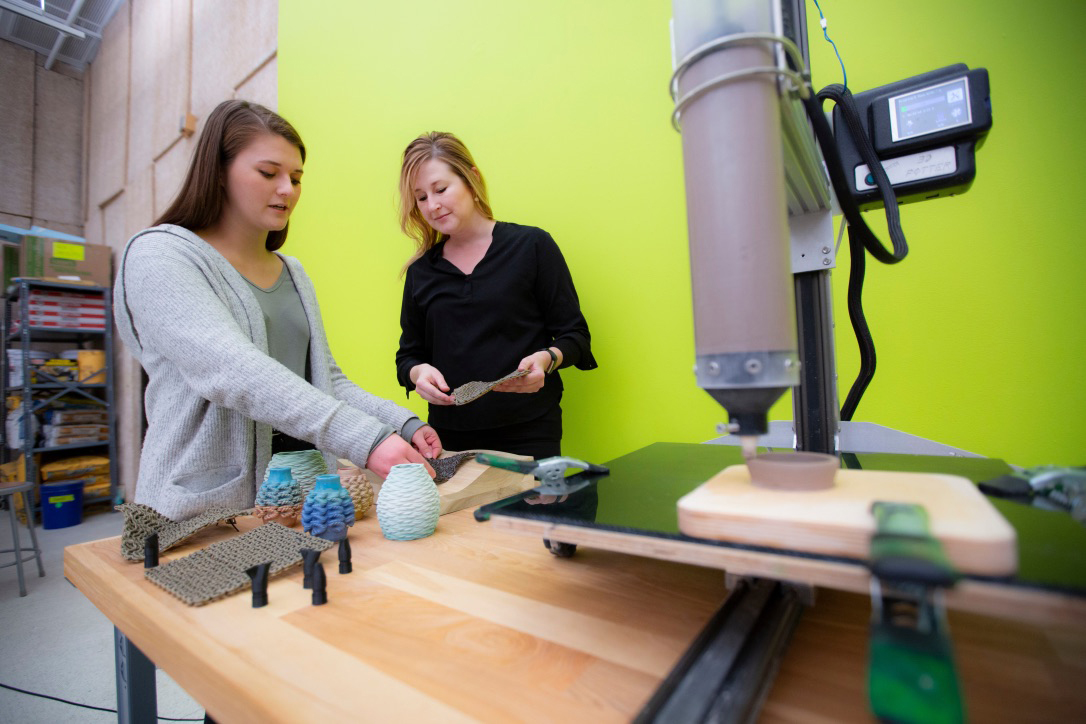
Under Construction
SEKI is a collection of eighty unique vases designed for President Wendy Wintersteen’s installation by Shelby Doyle, Erin Hunt, Kelly Devitt, and Ingrid Lilligren. Each vase represents the integration of custom-made glazes with computational designs and 3D ceramic printing.
The process began with developing a digital 3D model of each vase using a series of algorithms to create sets of geometry. From these digital models, code was produced that directed a ceramic 3D printer to deposit clay in thin layers, one layer at a time, to produce the vase. Once complete, the vases were dried, fired, glazed, and fired again. The palette of glaze colors was inspired by the University Museums’ Iowa College Pottery collection, thereby connecting advances in ceramic technology to its history at Iowa State. This collaboration was possible because the Iowa State University College of Design is one of the most comprehensive design colleges in the country: home to seven departments, fostering opportunities for unique multidisciplinary collaborations.
SEKI is the result of an ongoing partnership at the ISU Computation & Construction Lab (CCL) between the Department of Architecture and the ceramics studio in the Department of Art and Visual Culture at the College of Design.
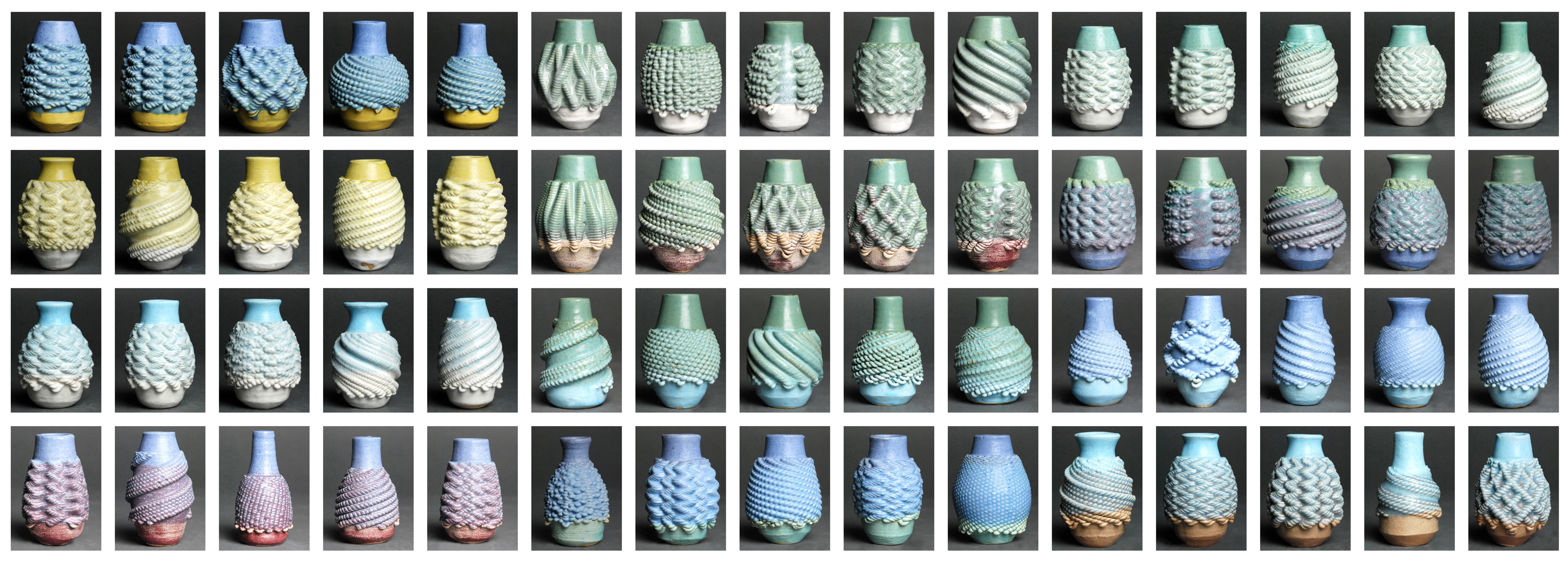

Re-Ordering architecture:
An Exhibition of Making Machine and Material Kin
Shelby Doyle, Frank Melendez and Nancy Diniz, Kelley Van Dyck Murphy, and Jonathan A. Scelsa with Greg Sheward
Usagi Gallery, Brooklyn, NY
NYC DESIGN Week 2023

rE-ordering architecture, four researchers establish new column styles with 3D-printed clay
By Davis Richardson for Architect’s Newspaper May 24, 2023
What does it mean to design entwined architecture?
An order in architecture is defined by a specific assemblage of parts subject to uniform established proportions and characteristics and is most readily identifiable by its metonymic column. Each column in this exhibition showcases a new “order”- a seed or fragment of an entwined future. These propositions offer neither apocalypse nor salvation. Rather this work grapples with questions of how architecture might measure, report, or act to produce entwinement between architecture and environment.
These four columns are fabricated by 3D printing clay, a process which requires reconsidering anthropocentric notions of authorship, precision, and control. Robotic processes on the one hand require a level of precision via computational command, but also an attentiveness to how the manual and synthetic hands interact and the feedback of the material in use. Clay is an ancient, visceral material that loops, slumps, and oozes - its live nature allows for manipulation in tandem with digital composition. This process establishes an odd kinship between the designer, tool, and material. The resulting projects explore rE-ordering architecture through making machine and material kin.
Riparian Flux proposes an architectural order where space is entwined with the ebb and flow of water, rather than a tool of control. In plan, the column is organized radially to create a single line that increases in curve amplitude from 0 to 12 rotations to support the column. In elevation the column measures 24 hours of printing and each slice serves as a method for measuring abundance, security, and hunger borrowing from the historic Nilometer.
Under Construction
